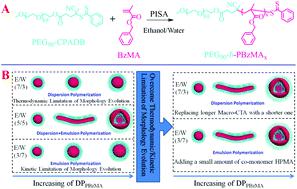当前位置:
X-MOL 学术
›
Polym. Chem.
›
论文详情
Our official English website, www.x-mol.net, welcomes your
feedback! (Note: you will need to create a separate account there.)
Influence of solvent on the RAFT-mediated polymerization of benzyl methacrylate (BzMA) and how to overcome the thermodynamic/kinetic limitation of morphology evolution during polymerization-induced self-assembly
Polymer Chemistry ( IF 4.1 ) Pub Date : 2022-05-30 , DOI: 10.1039/d2py00198e Cheng-Lin Yang 1 , Feng Zhong 2 , Cai-Yuan Pan 1 , Wen-Jian Zhang 1, 3 , Chun-Yan Hong 1
Polymer Chemistry ( IF 4.1 ) Pub Date : 2022-05-30 , DOI: 10.1039/d2py00198e Cheng-Lin Yang 1 , Feng Zhong 2 , Cai-Yuan Pan 1 , Wen-Jian Zhang 1, 3 , Chun-Yan Hong 1
Affiliation

|
Polymerization-induced self-assembly (PISA) has been demonstrated to be a powerful strategy to produce polymeric nano-objects of various morphologies. Dependent on the solubility of monomers, PISA is usually classified into two formulations as dispersion polymerization or emulsion polymerization, which may undergo quite different processes of polymerization and morphology transition. Generally, chain propagation of the solvophobic blocks will induce the morphology transition of the nano-objects from spherical micelles to higher order morphologies. However, the limitation of morphology evolution is often observed during PISA, and how to overcome the trapped spherical micelles obviously depends on case-by-case analysis. Herein, RAFT-mediated PISA of benzyl methacrylate (BzMA) in different formulations is investigated by varying the solvent composition (the mass ratio of ethanol/water). The polymerization kinetics, nucleation, and morphology transitions are quite different between these different PISA formulations. The morphology transition of spherical micelles, to worm-like micelles, and finally to vesicles is only observed at a moderate ratio of ethanol/water (5/5, w/w). At either a higher ratio of ethanol/water (7/3, w/w) or lower ratio of ethanol/water (3/7, w/w), morphology transitions of spherical micelles to the higher order ones are both limited, but the limited morphology transitions are caused by a different mechanism. The entrapped spherical micelles at ethanol/water = 7/3 (w/w) are determined by thermodynamic factors, and morphology transition can be achieved by using a shorter solvophilic polymer as the macro-RAFT agent, while the spherical micelles obtained at ethanol/water = 3/7 (w/w) are kinetically trapped, which can be overcome by copolymerization of some other monomers to improve the flexibility of solvophobic blocks. This work is promising as it provides a principle to overcome the limitations of morphology evolution in different cases and develops the design for formulations of PISA.
中文翻译:

溶剂对 RAFT 介导的甲基丙烯酸苄酯 (BzMA) 聚合的影响以及如何克服聚合诱导自组装过程中形态演化的热力学/动力学限制
聚合诱导自组装 (PISA) 已被证明是生产各种形态的聚合物纳米物体的有力策略。根据单体的溶解度,PISA通常分为分散聚合或乳液聚合两种配方,它们可能经历完全不同的聚合过程和形态转变。通常,疏溶剂嵌段的链增长将诱导纳米物体从球形胶束的形态转变为更高阶的形态。然而,在 PISA 过程中经常观察到形态进化的局限性,如何克服被困的球形胶束显然取决于个案分析。在此处,通过改变溶剂组成(乙醇/水的质量比)研究了 RAFT 介导的不同配方中甲基丙烯酸苄酯 (BzMA) 的 PISA。这些不同的 PISA 配方之间的聚合动力学、成核和形态转变非常不同。球形胶束、蠕虫状胶束和最终囊泡的形态转变仅在乙醇/水的中等比例(5/5,w/w)下观察到。在较高比例的乙醇/水(7/3,w/w)或较低比例的乙醇/水(3/7,w/w)下,球形胶束向高阶胶束的形态转变都是有限的,但有限的形态转变是由不同的机制引起的。在乙醇/水 = 7/3 (w/w) 处截留的球形胶束由热力学因素决定,通过使用较短的亲溶剂聚合物作为大分子 RAFT 剂可以实现形态转变,而在乙醇/水 = 3/7 (w/w) 下获得的球形胶束被动力学捕获,这可以通过其他一些共聚来克服单体以提高疏溶剂嵌段的柔韧性。这项工作很有前景,因为它提供了一个原则来克服不同情况下形态进化的局限性,并开发了 PISA 配方的设计。
更新日期:2022-05-30
中文翻译:

溶剂对 RAFT 介导的甲基丙烯酸苄酯 (BzMA) 聚合的影响以及如何克服聚合诱导自组装过程中形态演化的热力学/动力学限制
聚合诱导自组装 (PISA) 已被证明是生产各种形态的聚合物纳米物体的有力策略。根据单体的溶解度,PISA通常分为分散聚合或乳液聚合两种配方,它们可能经历完全不同的聚合过程和形态转变。通常,疏溶剂嵌段的链增长将诱导纳米物体从球形胶束的形态转变为更高阶的形态。然而,在 PISA 过程中经常观察到形态进化的局限性,如何克服被困的球形胶束显然取决于个案分析。在此处,通过改变溶剂组成(乙醇/水的质量比)研究了 RAFT 介导的不同配方中甲基丙烯酸苄酯 (BzMA) 的 PISA。这些不同的 PISA 配方之间的聚合动力学、成核和形态转变非常不同。球形胶束、蠕虫状胶束和最终囊泡的形态转变仅在乙醇/水的中等比例(5/5,w/w)下观察到。在较高比例的乙醇/水(7/3,w/w)或较低比例的乙醇/水(3/7,w/w)下,球形胶束向高阶胶束的形态转变都是有限的,但有限的形态转变是由不同的机制引起的。在乙醇/水 = 7/3 (w/w) 处截留的球形胶束由热力学因素决定,通过使用较短的亲溶剂聚合物作为大分子 RAFT 剂可以实现形态转变,而在乙醇/水 = 3/7 (w/w) 下获得的球形胶束被动力学捕获,这可以通过其他一些共聚来克服单体以提高疏溶剂嵌段的柔韧性。这项工作很有前景,因为它提供了一个原则来克服不同情况下形态进化的局限性,并开发了 PISA 配方的设计。











































 京公网安备 11010802027423号
京公网安备 11010802027423号